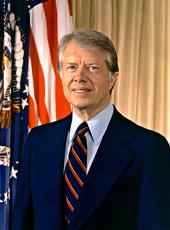Mr. Mellon, Bishop Walker, Mrs. Mondale, ladies and gentlemen:
In the name of the people of the United States of America, and on their behalf, I accept for the Nation this East Building of the National Gallery of Art.
I accept it with a full heart, with gratitude to all who have had a hand in its creation, and with a sense of exhilaration and joy that I know will be shared by the millions of people who will come here to look, to study, to contemplate, and to be moved and delighted and ennobled by what they find here.
This building is a gift of Paul Mellon, of his late sister, Ailsa Mellon Bruce, who's represented here by her grandchildren, and of the Andrew Mellon Foundation. We owe them thanks for the grandeur of their gift and for the modesty and grace with which it is given.
This building, too, is the product of many minds, of many hands, all intent on giving America their best. All have done so. I. M. Pei and his associates have given us an architectural masterpiece.
This great architect saw the unusual shape of the site not as an obstacle, but as an opportunity. And he has taken brilliant advantage of that opportunity. His design is sensitive to its surroundings. It is at once dignified and daring. It is monumental, yet without pomposity. And it reflects the human scale. It combines a reverence for the past with an eagerness for the future. It's worthy of the thousands of years of artistic creation that will be seen and studied under its roof.
J. Carter Brown, the Director of the National Gallery, has untiringly pursued the vision of a museum for people that would also be a center for art scholarship. Many others provided their skills and talents to this project, from the curators to the contractors, from the commissioned artists to the construction workers, who lovingly crafted each detail of the building, inside and out.
This beautiful building is an important addition to that unique repository of knowledge and culture, the Smithsonian Institution. Eight of its museums collect art, art that ranges from Vermeer to Pollock, from the sculpture of Henry Moore to the carved implements of the Eskimo people. With the addition of this building, the scope and definition of displayed art are both broader and deeper than ever before. With the private museums of this city, they make Washington a place where we may enjoy the full range of the creations of the human hand and the human eye.
This building tells us something about ourselves, about the role of art in our lives, about the relations between public life and the life of art, and about the maturing of an American civilization.
The beauty of this East Building and its location at the fulcrum of the ceremonial avenue of our Federal City will ensure that it takes its place alongside the Capitol Building and the Memorials as an emblem of our national life.
As the Capitol symbolizes our belief in political democracy and civil freedom, the National Gallery symbolizes our belief in the freedom and the genius of the human mind which is manifested in art.
In an open society like our own, the relationship between government and the arts must necessarily be a delicate one. We have no ministry of culture in this country, and I hope we never will. We have no official art in this country, and I pray that we never will. No matter how democratic a government may be, no matter how responsive to the wishes of its people, it can never be government's role to define exactly what is good or true or beautiful. Instead, government must limit itself to nourishing the ground in which art and the love of art can grow. So, within those limits, there is much that government can do, and much that we are doing.
In the past year we've increased substantially our support of the National Endowments for the Arts and for the Humanities. And much of that increase has come in the form of challenge grants, whereby government funds are matched with private donations.
Because we are committed to an open and flexible relationship, support for the arts and humanities flows through many different kinds of channels, leaving room for art and scholarship to develop naturally.
This Gallery, for example, is maintained at public expense, but it owes its existence to acts of private philanthropy. Moreover, acquisitions of works of art is financed entirely from private donations. It's equally significant that this building will serve both as a museum and as a center for art scholarship.
We have before us here in concrete, marble, and glass a tangible demonstration that excellence and access to a wide public are far from being contradictory. They are complementary. This building stands as a metaphor for what, at its best, the relationship between government and the arts can be.
When President Roosevelt dedicated the original National Gallery of Art on March 17, 1941, he said, "The dedication of this Gallery to a living past and to a greater and more richly living future is the measure of the earnestness of our intention that the freedom of the human spirit shall go on."
It did go on, and the building we dedicate today is a reaffirmation in this generation that human values, the expression of courage and love, in triumph over despair, will always endure.
Note: The President spoke at 2:13 p.m. outside the East Building. Prior to his remarks, John Walker, Episcopal Bishop of Washington, gave the invocation.
Following the ceremonies, the President toured the East Building.
Jimmy Carter, National Gallery of Art Remarks at Dedication Ceremonies for the East Building. Online by Gerhard Peters and John T. Woolley, The American Presidency Project https://www.presidency.ucsb.edu/node/245263


